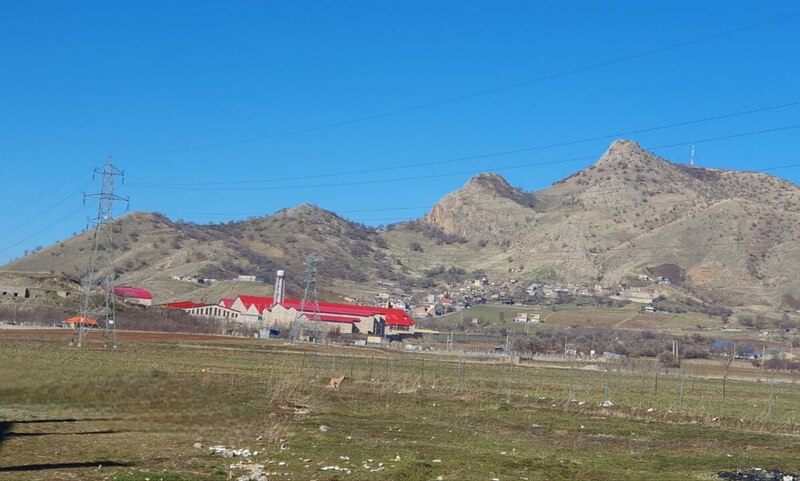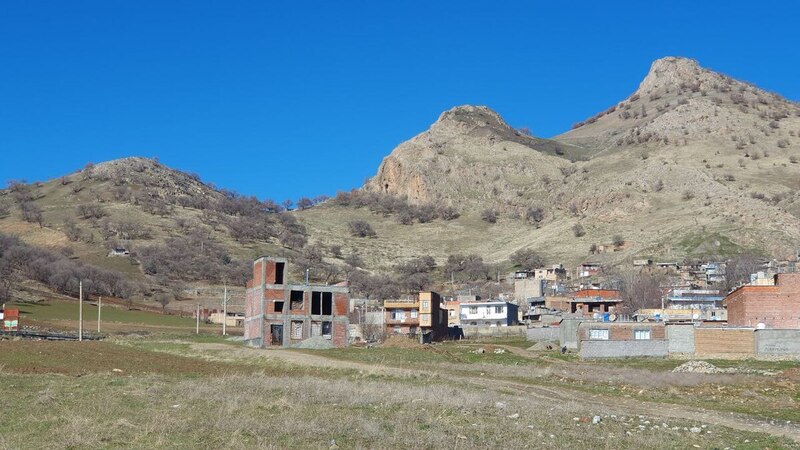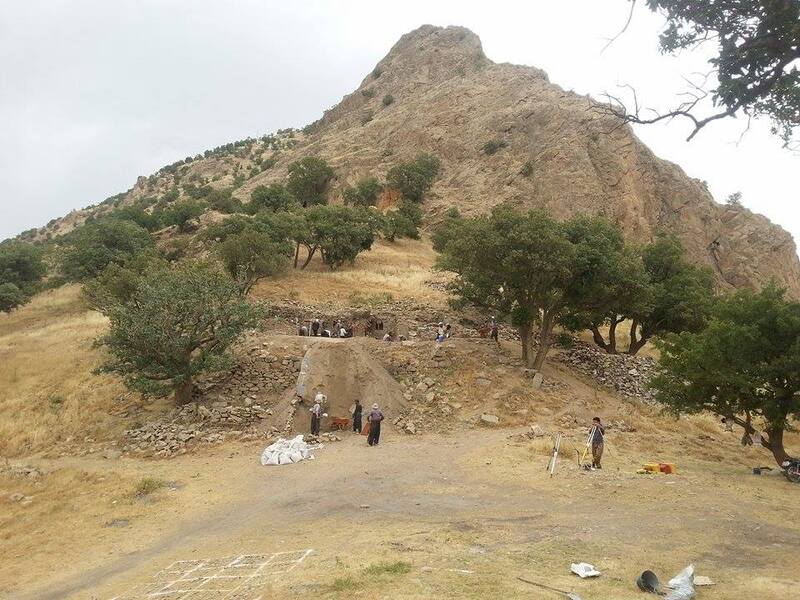One of the ancient and famous mosques in Kurdistan known as "Dar Al Elm" (A science school) with many wise, well-known theologists who have been educated in it is the Red Mosque of Marivan Castle which is historical evidence for this city. Marivan Castle is one of those monuments where a part of our history has been documented in it. This castle is located in the south of Marivan city on a mountain that is 1600 meters high in Marivan plain which is surrounded by three peaks that are rising like rebellious stallions and protecting the city.

Marivan is one of the famous cities in the East part of Kurdistan and it is located 20 kilometers away from the Bashmakh border. Some historical sources claim that this mountain and Marivan Castle were one of the Baban and Ardalan dynasty centers for ruling this area for three hundred years. This mountain used to be a castle city where many people used to live in it. In some historical books, this mountain is called the "three-peak" mountain and many other historical books call it "Marivan Castle" because this ancient castle was located on this mountain. The people of Marivan however, call it "Imam Mountain" because the tomb of a clergyman, "Imam Ahmad Anbari", is on this mountain.

The name Imam Mountain is derived from (Imam Sheikh Ahmad Ibn Al Anbari Al Na'imi) who was assigned to be the Red Mosque's Imam by Mir Hamza Baban in the 8th century Hijri. This mosque was ordered to be built by Amir Hamza Baban at the same time as the castle was being built. After "Imam Ahmad" passed away, they buried him in the cemetery next to the castle. This cemetery has become a sacred place since then.
Seyyed Abdul Samad Touwari talked about this in his book Nour Al Anwar: Amir Hamza Baban began a revolution and a war. He succeeded in capturing "Diyarbakir" and "Halab". The Turks and Arabs confronted him with great force but in the end they could not do much and finally they decided to cheat. They bribed Hamdoun Bag, the commander of Hamza Baban troops with a little money to surrender himself and his soldiers. When Amir Hamza stayed alone, he was forced to escape to Marivan with some of his commanders and settle in the three-peak mountain. After settling down, he began to gather more men for his army. He also built several castles over this mountain and its peaks with fortifications and ramparts to strengthen the castles.

Mir Hamza Baban built a mosque inside the castle over the mountain peak and appointed "Sheikh Ahmad Anbari" as the Imam of this mosque. He also appointed the highly-educated "Seyyed Ibrahim Barzanji" known as "Kabl" as the teacher and master of the Red Mosque. Kabl passed away in 823 Hijri. Two years later, Amir Hamza prepared a new and equipped army began a new battle, and succeeded in capturing all the cities reaching "Ba'qouba", however, he was poisoned and killed by some traitors (Touwari, 1970: 43)1.
Mullah Abdul Karim Modarres, from "Zanyaran Family" talked about Mir Hamza like this: «The government of the Babans was from the Babans of Qalachuwalan and from the 600 Hijri they have been active… we can mention Mir Abdul Karim, Mir Ahmad, Mir Sa'd Allah as the Amirs of this dynasty. The Book (Tazkarat Al Ajnad fi Maharbat Al Atrak wa Al Akrad) mentions these names elaborately» (Modarres, 1398: 212) 2.

Mir Hamza Baban built the mosque inside the castle in the 8th century Hijri. The outer wall of the mosque is made of red firebricks shaped like cubes which led to calling it the Red Mosque. This mosque and its Hujra (small classrooms for teaching Islamic subjects) became very popular later and it turned into one of the Dar Al Elms in Kurdistan. Tens of well-known religious theologists were educated here. It is worth mentioning that in 2015 an archeology team headed by Dr. Karimiyan, the chef of Tehran University Archeological Studies, accompanied by Dr. Ma'soumiyan, an archeology expert, researched and investigated Marivan Castle and the Red Mosque for months scientifically. They succeeded in uncovering the Red Mosque walls and the Hujras which were under a lot of dust and ruins with a great effort. The ruins of the mosque are full of red cubical firebricks. After the investigation and uncovering of the Red Mosque, the official organizations were supposed to pay a budget to help protect the monument however, it is forgotten and the place is left unattended and everyone can harm it. Perhaps the outside of the mosque was built with these red bricks and that is the reason for the name of Red Mosque. According to Dr. Ma'soumiyan, the mosque was destroyed by an earthquake. Finding human bones and skeletons indicates that during the earthquake, the mosque was being used by people.

Mullah Karim Modarres from the "Zanyaran Family" wrote about this mosque: when Halo Khan became the governor of Kurdistan, he chose Marivan castle as his ruling center. He ordered to repair and rebuild of the mosque. He invited Mullah Abubakr known as "Mosanef Chori" (who had just returned from Medina) to become the Red Mosque's Imam and tutor to help the students to be properly educated. After repairing the mosque, Halo Khan ordered to write this piece of poetry over the Red Mosque's alter (This is Halo Khan's great mosque, alas it will ruin someday). This verse is written in Abjad font which is in fact the year when the repair of the mosque was completed (Modarres, 1984, 497) 2.

At that time, the Red Mosque was rebuilt according to the Safavid architecture. Beck then, the important houses and buildings were built with red cubical bricks and Sarouj which is a kind of mortar made of red clay and lime mixed with several herbs' seeds. The Red Mosque was also built with such mortar. It is possible that the Red Mosque of Marivan would have been like the Red Mosque of Mahabad or the Hamamiyan Mosque of Bokan.
The Red Mosque and the houses of Marivan Castle-City along with its governor's building and military headquarters had remained till 1066 with many people living inside them however, this castle as well as "Zalm", "Palngan" and "Hassan Awa" castles were destroyed by "Suleiman Kahn", the governor of Ardalan state who was a friend and ally of "Shah Safi Safavi" one of the Safavid's kings of Iran and the people were forced to migrate to other places.

Sources:
Touwari, Seyyed Abd Al Samad (1970 z), a historical concept of Marivan and Hawraman, Mohammad Mullah Karim, Baghdad, Salman Al Ozma Publication.
Modarres, Mullah Abdul Karim (1398 sh), Zanyaran Family, Tehran, Ana.
Modarres, Abdul Karim (1984 z), Zanyaran Family, Baghdad, Safiq publication.








